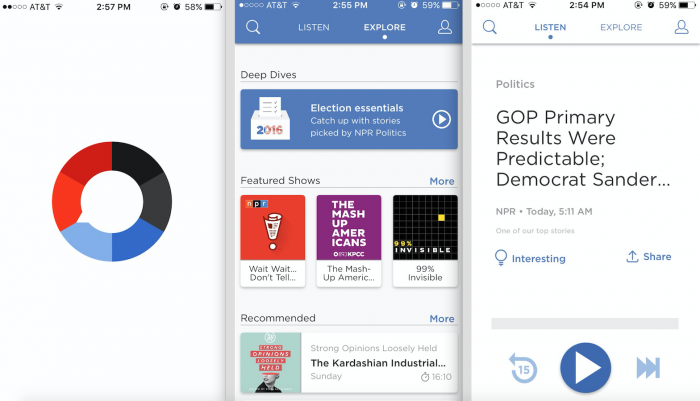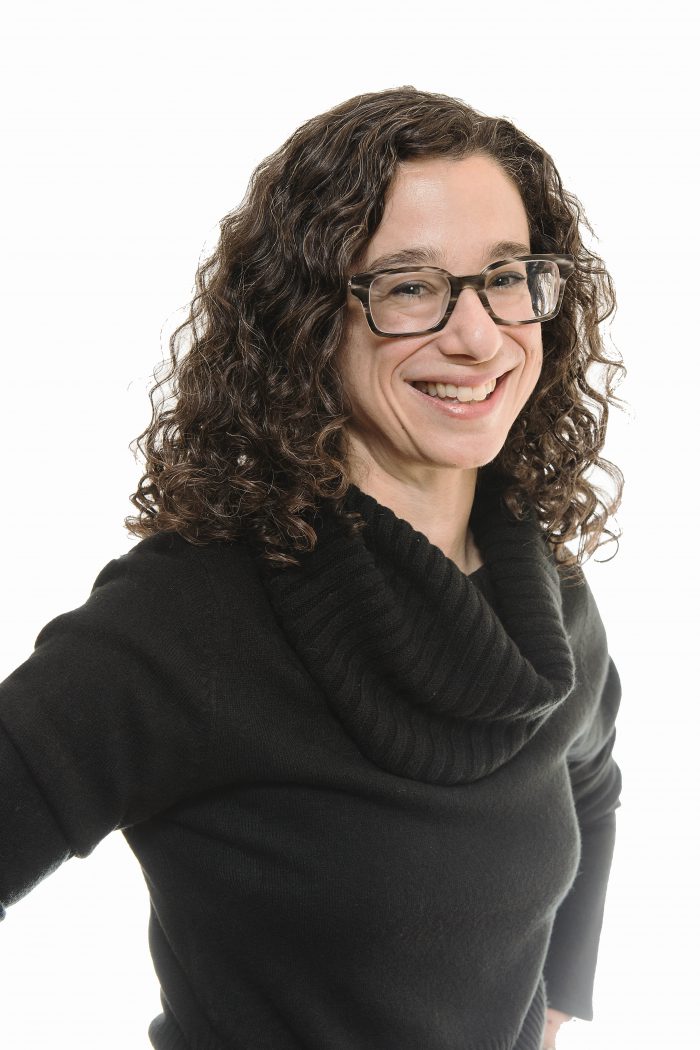
The NPR One app, which represents a way for public radio to reach listeners who might not be listening to terrestrial radio (at least not in any recognizable fashion), has been incorporating more and more local news into its stream. The relationship between local stations and NPR One can be mutually beneficial: the presence of a local newscast is the “single biggest indicator that a user will return to NPR One,” and NPR One can open up local stations to new audiences well beyond their geographic tower areas.
 NPR One’s new local editorial lead Tamar Charney, who previously led the newsroom at Michigan Radio, is a few months into the new role and speaks animatedly about the app’s potential to bring different types of “local” stories to audiences beyond NPR’s aging one.
NPR One’s new local editorial lead Tamar Charney, who previously led the newsroom at Michigan Radio, is a few months into the new role and speaks animatedly about the app’s potential to bring different types of “local” stories to audiences beyond NPR’s aging one.
There are new revenue opportunities, as well. The NPR One team, for instance, promoted a KALW podcast within the app to the national audience rather than the local audience, and the show got a big enough audience that they could begin selling sponsorships. (The app plays a stream of content based on a user’s selected home station and listening preferences, but also has some fixed elements: the national newscast and local newscast always play first when users open up the app.)
“In the old world of radio, radio was based very much upon towers. Towers are very geographically centered. More and more, we’re seeing the concept of local news that isn’t quite as geographically centered,” Charney said.
She also shrugged off the mid-March mini-controversy around NPR guidelines that stated NPR One would not be promoted on air (“for now”).“It was great publicity for us! And honestly, a tempest in a teapot. From my perspective, if I do my job right, stations are going to want to see this promoted,” she said. “At the end of the day, I don’t think it makes sense to promote something stations feels uncomfortable with, and that doesn’t represent their communities yet.”
The app has seen steady growth (though NPR hasn’t released its total number of users), and users now spend an average of 145 minutes a week listening in the app.
I spoke with Charney about how she manages relationships with local stations, what the NPR One team is doing to make sure the app feels more local, and the evolving concept of local journalism in the digital age. Our conversation, slightly edited for length and clarity, is below and also includes an extended hamster analogy.
A lot of things are best done by talking to people, rather than webinars or emails. That’s not to say I’m not doing those things, too. I’ve been traveling, I’ve done a couple of presentations, I’ve done a couple of webinars, I’ve been writing blog posts with tips on how to get started and what to put into the system and what we’re learning about local newscasts. But having actual conversations with people is so important, particularly with something that’s this new.
There are potentially 300 or so eligible stations. There are four types of local content people could be putting into NPR One, and some stations do all four. Others make some strategic decisions based on their resources to concentrate one one, two, maybe three of those. There are stations that just put their branding in. There are stations that put in their newscasts. There are stations that have a local podcast but no newscasts. There are stations that put in local feature reports but no newscasts. Some do both.
I’ve been trying to figure out how NPR One can best elevate local content, regardless of the strategic decisions a station made.
I think more stations are realizing that NPR is serious about this. Now they’re curious: What do we feed it? How many times does it need water? What kind of bedding does it like? I’m going to beat this pet analogy to the ground here. How does the hamster fit into our lifestyle? How do we make the workflow work? How is this going to work for our station in a way that’s sustainable and benefits us, and isn’t just an added burden?
We’re helping stations understand that maybe there are going to be workflow adjustments, and maybe you’re going to have to put out a little extra food in the morning, but here’s what you get in return: You’re getting a younger audience associating with your brand. You’re getting the email addresses of people who use NPR One. You’re reaching out, potentially, to people outside your geographic tower area. It’s about walking people through all the benefits of being involved and taking this added platform on in a meaningful way.But there are some really interesting success stories. KALW put a podcast called the Specialist into NPR One and we promoted it to the national audience instead of just the local audience. It was very good and interesting, and they got enough listenership to the podcast that they were able to sell sponsorships.
The old world of radio was based very much upon towers. Towers are very geographically centered. More and more, we’re seeing a concept of local news that isn’t as geographically centered. For example, the podcast We Live Here that St. Louis was doing was very much about post-Ferguson and the issues going on in St. Louis, but those are the same issues happening in a lot of other communities, too.
That was another podcast that we ended up promoting nationally, and while it was a local podcast about something very local, it had a different type of relevance. When we looked at the analytics, St. Louis was only the sixteenth market — there were fifteen other markets where people were listening to it. It was a local story that, while it wasn’t national, had these pockets of interest.
New tiers of local journalism are developing, with all the local journalism centers, the regional journalism centers, all these station-based collaborations.
Then there’s this sense of local topics that are local to a different type of geography, local to a certain type of affinity. You could have a small station in Maine that’s telling a story about the North Woods, and that’s a story that’s going to resonate across parts of Canada all the way out to Minnesota — anywhere people are having that North Woods experience.
The NPR One platform, ultimately, could start supporting something like that. It opens up some really interesting opportunities for stations to reach beyond what they see as their traditional audience. And they could possibly get sponsorships for their podcasts that they might not be able to get in their local communities.
Here in Michigan, for instance, there are essentially two different consortiums of stations. There’s one where all of the public radio stations in the state are part of a state capitol reporting consortium. Theoretically, all the stations in the consortium should be able to say, I’m a part of the Michigan Public Radio Network, and all the stories produced for the Michigan Public Radio Network will be available to all of those stations.
Right now, each station would individually upload each of those stories. Likewise, in the Detroit market, Michigan Radio and WDET are part of the Detroit Journalism Cooperative, which is a CPB-funded regional journalism center. There should be a way to share the content easily between members of the partnerships. There are about a dozen of these across the system, and more and more of them are pooling their resources and looking at the stories that make sense to tell as a collaboration, from a region, or a cohort of stations in communities that share similar issues.
I think those are all things that NPR One is perfectly positioned to support, with some tweaks. There’s still a huge place for the stations and local journalism and that structure, but I think it can be disseminated differently.
We’re now creating a system to automate all of this — it’s in the final stages of testing now. The system can take in the more standard formats, then convert them to the very specific format the NPR One system needs.
Pledge messaging shows up after about thirty or forty minutes of listening (that’s an estimate). It comes in the flow after a certain number of pieces, and the time can vary based on how long the pieces are and the choices people make. If somebody is skipping a lot, they’re not going to get a pledge message, because obviously they’re not having a great experience. There are some smart things around that. And stations have the ability to reach out to people who use their version of NPR One.
With terrestrial radio, you didn’t know who was listening, so the only way you had to reach people was over the air during pledge times. With NPR One, we do know who a lot of these people are, so there are more techniques at our disposal for gaining support. That’s a new way of thinking about it for people in public radio, because we’d always thought about it as on-air fund drives. NPR One is a different platform and a different technology, and we have to figure out how best to use it to create the revenue we need to continue doing the journalism people value.
And when I say we, I don’t necessarily mean NPR, I mean “we” as a public media system.

The person who crunches data for us and I did some analysis to try to figure out what makes a top newscast. A lot of it isn’t surprising. Newscasts can’t be too long; if they go on too long, people start dropping off. They have to sound like they actually belong in NPR One. They can’t sound like they were just grabbed out of Morning Edition.
I’m working this week on collecting tips from some of the stations who have newscasts that fared really well: What are our announcers thinking about when they’re recording it, how long did it take, how hard is it to do? Peer-to-peer learning is important, so stations can learn from each other how best to go about this.
Creating more curation abilities for stations over local content is going to be next. Right now there’s not a lot of control. Local stories go in, but it’s not as if stations are saying, hey, this is the first one I want to make sure the audience hears. We’re slowly going to start rolling out some curation tools and testing them as we go.
Right now, the newscasts appear at the top of the flow — national, then local. There are certain places where, for feature stories, the algorithm looks for something local. But eventually, I’d like the system to allow stations to put in the stories and give the system a little bit more information about them, like priority, or other factors.
There are also versions of stories created specifically for NPR One. There may be a series of reports, and those reports might be packaged into one piece — a self-contained unit for NPR One. That’s done nationally, and I’m pretty sure that’s been done locally by stations as well.
As for shows that only appear on NPR One, technically, how do you differentiate that from a podcast? There have been some special episodes of NPR podcasts that were released first in NPR One. In terms of an NPR One-only show, I don’t think anybody’s doing that yet, but I hope somebody does it!